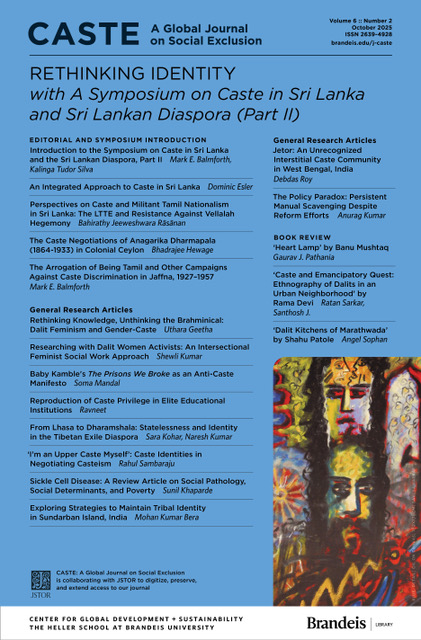From Lhasa to Dharamshala: Statelessness and Identity in the Tibetan Exile Diaspora
Main Article Content
Abstract
The article examines the forced migration and stateless existence of Tibetans due to China’s invasion of Tibet in 1950. As per the demographic survey conducted by Central Tibetan Administration (CTA) in 2009, approximately 80,000 Tibetans fled to neighbouring countries like India, Bhutan, and Nepal after the 1959 uprising against the Chinese government. It studies how exile has catalysed the formation of a transnational Tibetan identity. Drawing from diaspora and transnationalism theories, particularly the works of Clifford, Brah, and Schiller, the article analyses how these diasporic networks sustain a collective Tibetan consciousness. It then examines how Tibetan exile communities have used internet activism, education, religious continuity, and cultural preservation to maintain their identity and rally support from around the world. It interrogates India's nuanced involvement in the Tibet issue, striking a balance between geopolitical realism and historical links. It contends that the tenacity of the Tibetan diaspora, which is based on political optimism and cultural memory, represents a distinct diasporic formation in which statelessness serves as a means of belonging as well as a political statement.
Downloads
Article Details

This work is licensed under a Creative Commons Attribution 4.0 International License.
A. CORRESPONDING AUTHOR’S GRANT OF RIGHTS
The Corresponding Author grants to the Journal, during the full term of copyright and any extensions or renewals of that term, the following:
- An irrevocable non-exclusive right to reproduce, republish, transmit, sell, distribute, and otherwise use the Work in electronic and print editions of the Journal and in derivative works throughout the world, in all languages, and in all media now known or later developed.
- An irrevocable non-exclusive right to create and store electronic archival copies of the Work, including the right to deposit the Work in open access digital repositories.
- An irrevocable non-exclusive right to license others to reproduce, republish, transmit, and distribute the Work under the condition that the Authors are attributed. (Currently this is carried out by publishing the content under a Creative Commons Attribution 4.0 license.)
Copyright in the Work remains with the Authors.
B. CORRESPONDING AUTHOR’S DUTIES
- When distributing or re-publishing the Work, the Corresponding Author agrees to credit the Journal as the place of first publication.
- The Corresponding Author agrees to inform the Journal of any changes in contact information.
C. CORRESPONDING AUTHOR’S WARRANTY
The Corresponding Author represents and warrants that the Work is the Authors’ original work and that it does not violate or infringe the law or the rights of any third party and, specifically, that the Work contains no matter that is defamatory or that infringes any literary or proprietary rights, intellectual property rights, or any rights of privacy. The Corresponding Author also warrants that he or she has the full power to make this agreement, and if the Work was prepared jointly, the Corresponding Author agrees to inform the Authors of the terms of this Agreement and to obtain their written permission to sign on their behalf. The Corresponding Author agrees to hold the Journal harmless from any breach of the aforestated representations.
D. JOURNAL’S DUTIES
In consideration of the Author’s grant of rights, the Journal agrees to publish the Work, attributing the Work to the Authors.
E. ENTIRE AGREEMENT
This agreement reflects the entire understanding of the parties. This agreement may be amended only in writing by an addendum signed by the parties. Amendments are incorporated by reference to this agreement.
